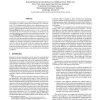Free Online Productivity Tools
i2Speak
i2Symbol
i2OCR
iTex2Img
iWeb2Print
iWeb2Shot
i2Type
iPdf2Split
iPdf2Merge
i2Bopomofo
i2Arabic
i2Style
i2Image
i2PDF
iLatex2Rtf
Sci2ools
HPCA
1998
IEEE
1998
IEEE
Exploiting Two-Case Delivery for Fast Protected Messaging
We propose and evaluate two complementary techniques to protect and virtualize a tightly-coupled network interface in a multicomputer. The techniques allow efficient, direct application access to network hardware in a multiprogrammed environment while gaining most of the benefitsof a memory-basednetwork interface. First, two-case delivery allows an application to receive a message directly from the network hardware in ordinary circumstances, but provides buffering transparently when requiredfor protection. Second, virtual buffering stores messages in virtual memory on demand, providing the convenience of effectively unlimited buffer capacity while keepingactualphysicalmemoryconsumptionlow. The evaluation is based on workloads of real and synthetic applications running on a simulator and partly on emulated hardware. The results show that the direct path is also the common path, justifying the use of software buffering. Further results show that physical buffering requirements remain lo...
Buffering Stores Messages | Distributed And Parallel Computing | HPCA 1998 | Network Hardware | Physical Buffering Requirements |
| Added | 04 Aug 2010 |
| Updated | 04 Aug 2010 |
| Type | Conference |
| Year | 1998 |
| Where | HPCA |
| Authors | Kenneth Mackenzie, John Kubiatowicz, Matthew Frank, Walter Lee, Victor Lee, Anant Agarwal, M. Frans Kaashoek |
Comments (0)

